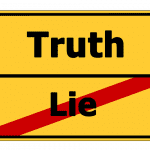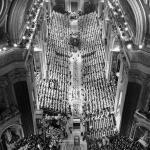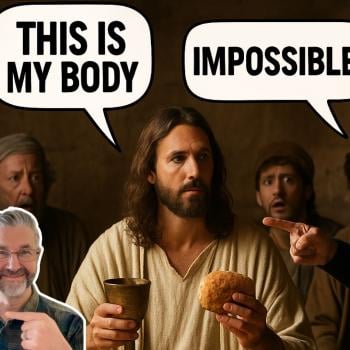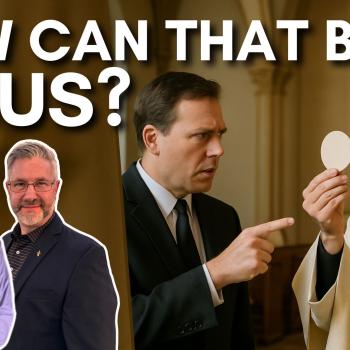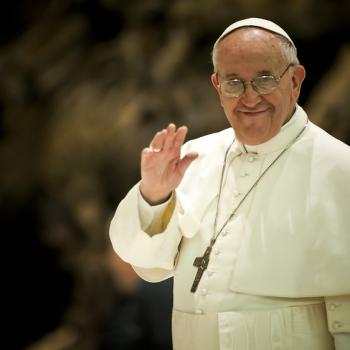
[see the Master List of all twelve installments]
Paolo Pasqualucci (signer of three of the endless reactionary-dominated “corrections” of Pope Francis), a Catholic and retired professor of philosophy of the law at the University of Perugia, Italy, wrote “‘Points of Rupture’ of the Second Vatican Council with the Tradition of the Church – A Synopsis” (4-13-18), hosted by the infamous reactionary site, One Peter Five. It’s an adaptation of the introduction to his book Unam Sanctam – A Study on Doctrinal Deviations in the Catholic Church of the 21st Century.
Pope Benedict XVI, writing as Cardinal Ratzinger, stated that the authority of Vatican II was identical to that of the Council of Trent:
It must be stated that Vatican II is upheld by the same authority as Vatican I and the Council of Trent, namely, the Pope and the College of Bishops in communion with him, and that also with regard to its contents, Vatican II is in the strictest continuity with both previous councils and incorporates their texts word for word in decisive points . . .
Whoever accepts Vatican II, as it has clearly expressed and understood itself, at the same time accepts the whole binding tradition of the Catholic Church, particularly also the two previous councils . . . It is likewise impossible to decide in favor of Trent and Vatican I but against Vatican II. Whoever denies Vatican II denies the authority that upholds the other two councils and thereby detaches them from their foundation. And this applies to the so-called ‘traditionalism,’ also in its extreme forms. Every partisan choice destroys the whole (the very history of the Church) which can exist only as an indivisible unity.
To defend the true tradition of the Church today means to defend the Council. It is our fault if we have at times provided a pretext (to the ‘right’ and ‘left’ alike) to view Vatican II as a ‘break’ and an abandonment of the tradition. There is, instead, a continuity that allows neither a return to the past nor a flight forward, neither anachronistic longings nor unjustified impatience. We must remain faithful to the today of the Church, not the yesterday or tomorrow. And this today of the Church is the documents of Vatican II, without reservations that amputate them and without arbitrariness that distorts them . . .
I see no future for a position that, out of principle, stubbornly renounces Vatican II. In fact in itself it is an illogical position. The point of departure for this tendency is, in fact, the strictest fidelity to the teaching particularly of Pius IX and Pius X and, still more fundamentally, of Vatican I and its definition of papal primacy. But why only popes up to Pius XII and not beyond? Is perhaps obedience to the Holy See divisible according to years or according to the nearness of a teaching to one’s own already-established convictions? (The Ratzinger Report, San Francisco: Ignatius, 1985, 28-29, 31)
For further basic information about the sublime authority of ecumenical councils and Vatican II in particular, see:
Conciliar Infallibility: Summary from Church Documents [6-5-98]
The Bible on Papal & Church Infallibility [5-16-06]
Authority and Infallibility of Councils (vs. Calvin #26) [8-25-09]
The Analogy of an Infallible Bible to an Infallible Church [11-6-05; rev. 7-25-15; published at National Catholic Register: 6-16-17]
“Reply to Calvin” #2: Infallible Church Authority [3-3-17]
“On Adhesion to the Second Vatican Council” (Msgr. Fernando Ocariz Braña, the current Prelate of Opus Dei, L’Osservatore Romano, 12-2-11; reprinted at Catholic Culture) [includes discussion of VCII supposedly being “only” a “pastoral council”]
Pope Benedict on “the hermeneutic of reform, of renewal within continuity” (12-22-05)
The words of Paolo Pasqualucci, from his article, noted above, will be in blue:
*****
14. The unheard of novelty of the introduction into the Liturgy of the principle of creativity, again in SC, paragraphs 37-40, theoretically under the control of the Holy See, often purely “theoretical”. This principle has always been opposed down the centuries by the entire Magisterium, without exceptions, as a disastrous thing to be avoided in the most absolute way, and many consider this principle to be the real cause of the current liturgical chaos.
15. The principle of creativity is corroborated by the wide and entirely new competence given to the Bishops’ Conferences in liturgical matters, including the faculty of experimenting new forms of worship (SC 22 § 2, 39, 40); this is contrary to the constant teaching of the Magisterium, which has always reserved all competence in liturgical matters to the Supreme Pontiff, as the maximum guarantee against the introduction of liturgical innovations.
This is the accusation against Sacrosanctum Concilium, with regard to these sections:
D) Norms for adapting the Liturgy to the culture and traditions of peoples
37. Even in the liturgy, the Church has no wish to impose a rigid uniformity in matters which do not implicate the faith or the good of the whole community; rather does she respect and foster the genius and talents of the various races and peoples. Anything in these peoples’ way of life which is not indissolubly bound up with superstition and error she studies with sympathy and, if possible, preserves intact. Sometimes in fact she admits such things into the liturgy itself, so long as they harmonize with its true and authentic spirit.
38. Provisions shall also be made, when revising the liturgical books, for legitimate variations and adaptations to different groups, regions, and peoples, especially in mission lands, provided that the substantial unity of the Roman rite is preserved; and this should be borne in mind when drawing up the rites and devising rubrics.
39. Within the limits set by the typical editions of the liturgical books, it shall be for the competent territorial ecclesiastical authority mentioned in Art. 22, 2, to specify adaptations, especially in the case of the administration of the sacraments, the sacramentals, processions, liturgical language, sacred music, and the arts, but according to the fundamental norms laid down in this Constitution.
40. In some places and circumstances, however, an even more radical adaptation of the liturgy is needed, and this entails greater difficulties. Wherefore:
1) The competent territorial ecclesiastical authority mentioned in Art. 22, 2, must, in this matter, carefully and prudently consider which elements from the traditions and culture of individual peoples might appropriately be admitted into divine worship. Adaptations which are judged to be useful or necessary should then be submitted to the Apostolic See, by whose consent they may be introduced.
2) To ensure that adaptations may be made with all the circumspection which they demand, the Apostolic See will grant power to this same territorial ecclesiastical authority to permit and to direct, as the case requires, the necessary preliminary experiments over a determined period of time among certain groups suited for the purpose.
3) Because liturgical laws often involve special difficulties with respect to adaptation, particularly in mission lands, men who are experts in these matters must be employed to formulate them.
[. . .]
2. In virtue of power conceded by the law, the regulation of the liturgy within certain defined limits belongs also to various kinds of competent territorial bodies of bishops legitimately established. [sec. 22]
[. . .]
In this instance, we have a case of flawed implementation of the council’s directives: the infamous “spirit of Vatican II.” I shall cite at length from “True Development of the Liturgy” (Archbishop Malcolm Ranjith [then secretary of the Congregation for Divine Worship and Discipline of the Sacraments in Rome, First Things, May 2009):
How much of the postconciliar liturgical reform truly reflects Sacrosanctum Concilium , the Second Vatican Council’s Constitution on Sacred Liturgy? . . .
[H]owever much the popes who guided this event insisted on the need for a true spirit of reform, faithful to the essential nature of the Church, and even if the council itself produced such beautiful theological and pastoral reflections as Lumen Gentium, Dei Verbum, Gaudium et Spes, and Sacrosanctum Concilium, what happened outside the council—especially within the society at large and the circle of its philosophical and cultural leadership—began to influence it negatively, creating tendencies that were harmful to its life and mission.
These tendencies, which at times were even more virulently represented by certain circles within the Church, were not necessarily connected to the orientations or recommendations of the documents of Vatican II. Yet they were able to shake the foundations of ecclesial teaching and faith to a surprising extent. Society’s fascination with an exaggerated sense of individual freedom—and its penchant for the rejection of anything permanent, absolute, or otherworldly—had its influence on the Church and often was justified in the name of the council. . . .
Joseph Cardinal Ratzinger had this to say on the ever increasing spirit of relativism: “Already during its sessions and then increasingly in the subsequent period, [the true council] was opposed by a self-styled “Spirit of the Council,’ which in reality is a true “anti-spirit’ of the council. According to this pernicious anti-spirit, everything that is “new’ . . . is always and in every case better than what has been or what is. It is the anti-spirit according to which the history of the Church would first begin with Vatican II, viewed as a kind of point zero.” . . .
Liturgists had also tended to pick and choose sections of Sacrosanctum Concilium that seemed to be more accommodating to change or novelty, while ignoring others. Besides, there was a great sense of hurry to effect and legalize changes. Much space tended to be provided for a rather horizontalist way of looking at the liturgy. Norms of the council that tended to restrict such creativity or that were favorable to the traditional way seemed to be ignored.
Worse still, some practices that Sacrosanctum Concilium had never contemplated were allowed into the liturgy, such as saying the Mass versus populum , Holy Communion on the hand, altogether giving up on Latin and Gregorian Chant in favor of the vernacular and songs and hymns without much space for God, and extension beyond any reasonable limits of the faculty to concelebrate at Holy Mass. There was also the gross misinterpretation of the principle of “active participation” (actuosa participatio). . . .
What is most clear to any reader of Giampietro’s True Development of the Liturgy is that, as Cardinal Ratzinger stated, “the true time of Vatican II has not yet come.” The reform has to go on. The immediate need seems to be that of a reform of the Missal of 1969, for quite a number of changes originating within the postconciliar reform seem to have been introduced somewhat hastily and unreflectively, as Cardinal Antonelli himself repeatedly stated. The change must be made to fall in line with Sacrosanctum Concilium itself, and it must indeed go even further, keeping with the spirit of our own times.
Cardinal Robert Sarah: prefect for the Congregation for Divine Worship and the Discipline of the Sacraments, also has made it clear that liturgical abuses ran contrary to the true nature of Sacrosanctum Concilium:
Certainly, the Second Vatican Council wished to promote greater active participation by the people of God and to bring about progress day by day in the Christian life of the faithful (see Sacrosanctum Concilium, n. 1). Certainly, some fine initiatives were taken along these lines. However we cannot close our eyes to the disaster, the devastation and the schism that the modern promoters of a living liturgy caused by remodeling the Church’s liturgy according to their ideas. They forgot that the liturgical act is not just a PRAYER, but also and above all a MYSTERY in which something is accomplished for us that we cannot fully understand but that we must accept and receive in faith, love, obedience and adoring silence. And this is the real meaning of active participation of the faithful. . . .
Many Catholics do not know that the final purpose of every liturgical celebration is the glory and adoration of God, the salvation and sanctification of human beings, since in the liturgy “God is perfectly glorified and men are sanctified” (Sacrosanctum Concilium, n. 7). Most of the faithful—including priests and bishops—do not know this teaching of the Council. Just as they do not know that the true worshippers of God are not those who reform the liturgy according to their own ideas and creativity, to make it something pleasing to the world, but rather those who reform the world in depth with the Gospel so as to allow it access to a liturgy that is the reflection of the liturgy that is celebrated from all eternity in the heavenly Jerusalem. As Benedict XVI often emphasized, at the root of the liturgy is adoration, and therefore God. (“Adapting the Liturgy to Our Decadence,”The Catholic Thing, 4-19-17)
Fr. Peter M. J. Stravinskas highlighted the same stark contrast between Sacrosanctum Concilium and the liturgical confusion that followed:
When people talk about liturgy in the contemporary Church, they tend to begin with the Second Vatican Council, which is about a century too late. Sacrosanctum Concilium, the conciliar Constitution on the Sacred Liturgy did not emerge full-blown from the brow of Zeus; rather, it was the culmination of a century-long liturgical movement, “canonized” by Pope St. Pius X and especially by Pope Pius XII in Mediator Dei. . . .
Sacrosanctum Concilium did not come up with a new vision of divine worship; it merely solidified the aspirations of liturgical scholars and the Magisterium of the previous hundred years. Very often when Vatican II is mentioned, especially in regard to liturgy, people start to talk about “the changes” effected there. Truth be told, that document was not about “changes,” which is why we read the following:
That sound tradition may be retained, and yet the way remain open to legitimate progress careful investigation is always to be made into each part of the liturgy which is to be revised. This investigation should be theological, historical, and pastoral. Also the general laws governing the structure and meaning of the liturgy must be studied in conjunction with the experience derived from recent liturgical reforms and from the indults conceded to various places. Finally, there must be no innovations unless the good of the Church genuinely and certainly requires them; and care must be taken that any new forms adopted should in some way grow organically from forms already existing. (n. 23)
In other words, no “changes” were to be made, unless they were manifestly necessary. And so, the Council Fathers insisted on the maintenance of Latin, except for the readings and homily; called for the restoration of the prayer of the faithful and offertory procession, and for an expanded lectionary, so that the faithful might receive a greater exposure to the Word of God. That’s it. . . .
In the list of items I delineated for you a few minutes ago, I trust you noticed that there was no mention of: Mass facing the people; altar girls; extraordinary ministers of Holy Communion; Communion in the hand; a total vernacular liturgy. In most instances, these practices were introduced by would-be reformers in direct defiance of existing liturgical norms. When corrected, these “reformers” continued on their merry way, absent discipline from bishops. In other words, disobedience was rewarded. Some time back, I asked a bishop who had been a Council Father for all four sessions of the synod, what his confreres would think of these changes not authorized by the Council. He gave the stark reply: “They would be horrified.” . . .
In the past few years, Ratzinger’s mantle of reform has been assumed by the Guinean Robert Cardinal Sarah. Two works of his are particularly valuable: God or Nothing and The Power of Silence: Against the Dictatorship of Noise. He was appointed by Pope Francis in 2014 to serve as the prefect for the Congregation for Divine Worship and the Discipline of the Sacraments. Although Francis does not have much of a liturgical sense or appreciation, it is interesting that he told Sarah he wanted him to pursue the vision sketched out by Ratzinger. Which he has done – in spades. He has spoken forcefully and convincingly about the need: to return to the celebration of Holy Mass with priest and people facing the same direction – liturgical East; to restore generous amounts of Latin; for Holy Communion to be administered on the tongue to one kneeling. (“Liturgical Vision vs. Liturgical Visions: Vatican II, Pope Benedict XVI, Cardinal Sarah,” The Catholic World Report, 3-15-18)


